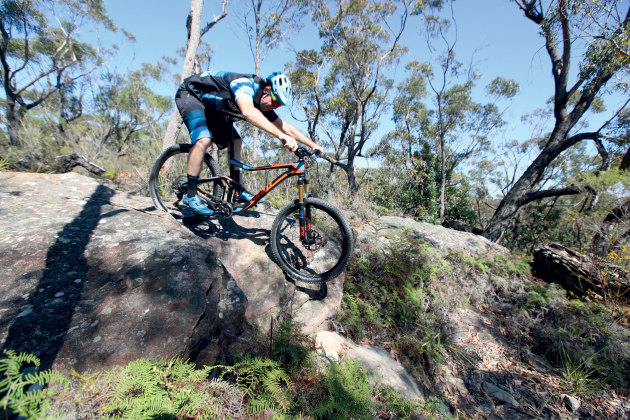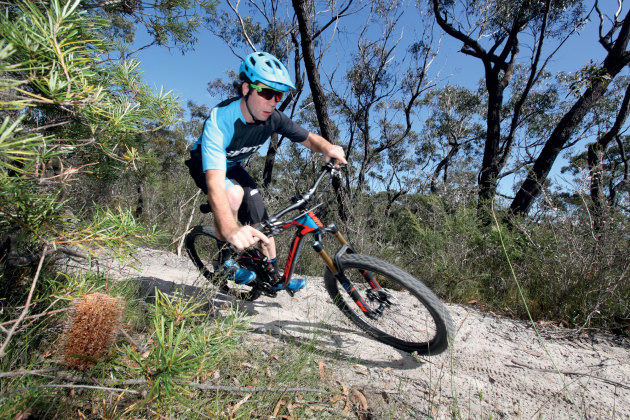Ride Better with a Dropper Post
While dropper posts are now gaining broader acceptance, a large number of riders remain sceptical of the benefits. Some of the most common rebuttals include:
• I don’t ride steep descents and therefore don’t need a dropper post.
• I can ride any drop or descent with my saddle at full XC race height – just you watch me!
• Descending feels weird without a saddle between my legs and I need it as a reference point.
• I’ve got a dropper post but always forget to use it; thinking of removing it as a result.
• Dropper posts add too much weight.
If any of those comments sound familiar, I suggest you read on.
While I now stand as a dropper post evangelist, it hasn’t always been that way. With a background in XC racing, I used to be quite proud of the fact I could tackle any of the local DH tracks with my seat at full height. I was also reluctant to add an extra 250g to my bike. It wasn’t that I couldn’t hack an extra 250g – the equivalent of a half empty drink bottle – it was more that I was trying to keep my 125mm travel trail bike under the 11kg mark, and a dropper was going to push it over that metaphoric figure. Additionally, I wasn’t keen to add an extra lever and cable to my handlebars as I felt that it added too much clutter—all silly stuff in hindsight.
Still, with all the talk of dropper posts, I thought I should try one—that was in 2011. With all my phobias of weight and clutter, I chose to run a non-remote dropper post. It had a lever under the saddle, so you had to take a hand off the bars and reach between your legs to drop the saddle. In retrospect this was another mistake, as the dropper only saw action for a prolonged descent; the rest of the time it was too much hassle to use.
Initially it felt strange to ride with the saddle dropped. I was used to having the saddle as a reference point and it took quite a while to become accustomed to the new feel. I stuck with it however and over time I began to notice the benefits.
Riding the Steeps
As mentioned earlier, I could already descend our steepest trails. What changed was the level of confidence on this terrain; instead of picking my way gingerly down, I was off the brakes and letting the bike roll. Much of this was due to the additional freedom of movement gained once the saddle was out of the way. You can get your body lower on the bike while remaining centred, and this adds control and confidence while making you less likely to go over the bars.


Corner with Conviction
In a way this was expected; dropper posts are for riding steep stuff right? What I didn’t expect was the newfound cornering speed. Two factors contribute to this; a lower saddle allows you to get lower on the bike gives you a lower centre of gravity. This delivers a distinct boost in cornering ability for the same reason that a low to the ground sports car will corner faster than a raised 4WD.
The other key part is that it becomes easier to move the bike from side-to-side when the saddle is out of the way. Watch a skilled rider corner and you’ll see they lean the bike independently from their body—this becomes far easier and you can swap from turning left to right with greater fluidity. In short, it’s easier to become a better rider without a saddle hindering your movement on the bike.
These benefits were most obvious when tackling a steep downhill turn, but more and more I noticed that dropping the saddle helped on any sort of corner—even on flatter ground. The increased cornering ability was addictive and I wanted access to it all the time, something that wasn’t practical with my lever under the saddle arrangement.

Learning Curve
So on went a different dropper post, this time with a handlebar remote fitted. This setup allows the saddle to be dropped at any time without breaking your rhythm. Again there’s a learning curve here if you’re a dropper post newbie. There will be times when you go through a twisty bit of trail and realise afterwards that you didn’t drop the saddle. Persevere through the first month or so, use the dropper at every given opportunity (not just on the steep stuff) and the action will become second nature.
On a singletrack heavy ride I’ll probably change my saddle height as much or more often than I change gears. Any sort of descent? Drop the saddle. One or two fast corners in succession? Drop the saddle. Off-camber bit of trail? Drop the saddle. High speed G-outs? Drop the saddle again. For virtually anything other than climbing and non-technical fire road pedalling, lowering your saddle height improve your control and agility. Importantly, it allows you to better utilise the most effective suspension available; your arms and legs!
On more technically challenging trails with loads of turns, drops and rocks, the low position tends to become the default setting. Sitting down lets you have a rest and at first you’ll miss this, but over time you grow accustomed to standing for longer periods and gain stronger core as a result. Hitting the dropper remote becomes an instantaneous reaction – just like changing gears – and riding with the saddle rammed up your clacker will feel very restrictive. The resulting aversion to having the saddle up over anything remotely technical won’t be due to a lack of skill. It’s just your riding ability will have moved up a notch and any fixed height post will feel like a regressive step.
So what’s the point of this narration? Well my message can be surmised as follows:
• Dropper posts aren’t just for steep stuff.
• Lowering the saddle will allow you to improve your cornering technique (think lower and faster).
• Without the saddle in the way, you’ll be better able to use your arms and legs as suspension.
• It takes time to get used to a dropper; don’t give up on it because you forget to use it initially.
• It’ll feel odd at first without the saddle as a reference point but don’t bail on the concept due to unfamiliarity.
• Choose one with an easy to reach handlebar remote or you’ll be selling yourself short.
• Use it often and it’ll become second nature—I even use it to make hopping on and off the bike easier.
• The weight gain is insignificant relative to the confidence and performance gain and before long you’ll be seeing the top XC racers using dropper posts on their hardtails—mark my words!







